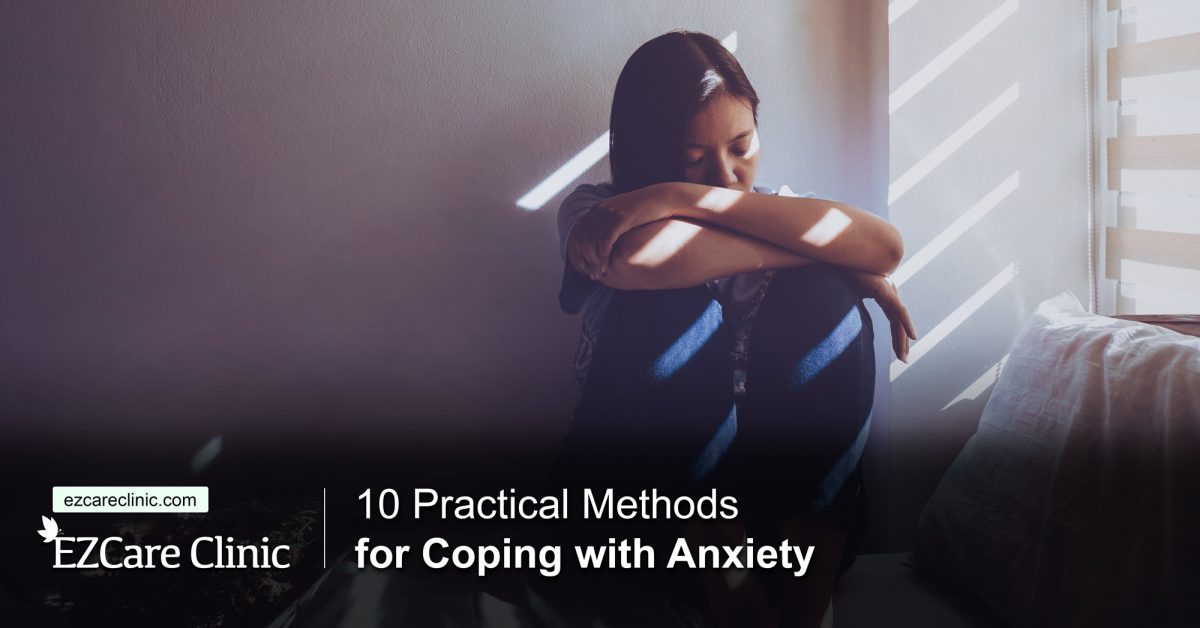Are you suffering from anxiety? Its symptoms include a strong urge to avoid crowds, increased heart rate, throbbing headaches, and an immense fear of getting judged. Others are restlessness, fatigue, low concentration, irritability, panic attacks, and insomnia. Once you experience these symptoms, it will be hard to move, feel, think, or behave normally. Your body will also experience physical pain. In such instances, you may feel like switching off until the discomfort passes.
Regain your mental health by clicking the button below!
According to statistics, over 40 million Americans are battling anxiety disorders. Of these, only 36.9% receive proper treatment. That’s because most sufferers solely depend on medication. If you look beyond the pills, you’ll discover several permanent anxiety coping methods. Once you start researching the right solutions to anxiety, you’ll uncover a flood of options. Finding one that works for you can be an uphill task. This information overload could also make your anxiety worse.
I can help you by giving you a definitive solution. In this article, I’ll provide the most genuine answers to make you regain control despite the various challenges you’ll face. Let’s discuss them in detail.
An Overview of Anxiety and Why It’s a Dreaded Diagnosis
Anxiety is a feeling of temporary detachment from oneself. It can be no different from feeling happy, as it has a moderate role in human emotions. For example, your heart might beat faster before interacting with a crowd. You might also experience nervousness before or during an interview.
Don’t worry about mild anxiety if you can control your feelings. Our environment determines what we feel, so anxiety isn’t necessarily a bad emotion. It can give you the morale you need to stay organized and prepared. Anxiety also equips you with the intuition to perceive imminent danger and the confidence to determine possible risks.
While it has its positive attributes, anxiety can also have harmful effects on your mental wellbeing. Panic attacks interfere with your daily activities and are hard to control. They involve persisted, intense, and repeated fears that are mostly blown out of proportion. Panic attacks can cause feelings of terror or fear in minutes. Some symptoms start during childhood and teenagehood and continue well into adulthood.
How do you deal with such uncertainties? Pay attention as I outline foolproof ways of permanently treating anxiety. The coping methods for anxiety are mentioned below:
1. Cognitive Behavioral Therapy (CBT)
The sooner you identify the root cause of your anxiety, the more likely you’re to implement a viable solution. CBT is a psychotherapeutic treatment that helps you pinpoint and change harmful thought patterns that trigger anxiety. It also prevents your brain from forming such thoughts. In simple terms, this treatment keeps your thoughts positive. CBT is a game-changer because it adjusts your reactions to scenarios or objects that trigger anxiety. CBT has the following specific approaches:
-
Cognitive therapy
It involves changing distorted thinking. Irrational thoughts include forecasting negative results to future events and having a self-defeatist mentality. You might also imagine that other people are judging you even when that’s not the case.
-
Dialectical behavior therapy (DBT)
This type of CBT teaches you to manage stress, emotions, and the relationship with those around you. It also shows you how to appreciate the present without focusing on past adverse events or future uncertainties.
-
Multimodal therapy
It treats anxiety by focusing on seven specific modalities: behavior, sensation, imagery, affect, interpersonal connections, cognition, and biological needs.

Effective Therapies from Anxiety
-
Rational emotive behavior therapy (REBT)
This type of therapy starts by identifying illogical thoughts and beliefs and confronting them. REBT teaches you how to recognize and change these irrational thought patterns. The behavioral aspect of CBT focuses on the interconnection between your thoughts, problems, and behavior. The psychotherapy portion of it concentrates on your childhood thought patterns and the personal meaning of things around you.
CBT involves the following steps:
-
Identify negative thoughts
Anxiety projects more aggressive versions of otherwise typical scenarios. Take the example of someone who has a phobia of bugs. The fear might extend to plants, grass, and other greenery they think might be hosting the bugs. The key is to try to remember your thought patterns before your anxiety started.
Introspection can unearth useful insights that will help with your treatment. Your therapist will practically show you that the cause of your anxiety isn’t as bad as you imagine it to be.
-
Confront your negative thoughts
After identifying your anxiety triggers, you’ll have more courage to challenge them. Repeated exposure might end up normalizing your experience with them and reduce exaggerated responses. You can analyze anxiety triggers by:
- Actively evaluating your thoughts for negative patterns
- Picking out beliefs that increase confusion instead of making things easier
- Testing whether negative feelings are valid or blown out of proportion.
Try the following strategies if you want to conquer your fears:
- Perform experiments by coming up with various scenarios that might cause anxiety.
- List the pros and cons of avoiding the situations you fear.
- Analyze the logical chances of such situations occurring.
Get an effective nursing care plan for anxiety at your ease by clicking the button below!
-
Replace or minimize negative thoughts
This phase is the final step in getting rid of anxiety triggers. Now that you understand the cons of irrational thoughts, you can stop focusing on them. Replace them with positive emotions that align accurately with real-world expectations. As your therapist, I will help you nurture encouraging statements to boost your morale whenever you’re feeling down.
One of CBT’s most significant advantages is that it shows results in a relatively short time. Severe emotional issues can be resolved in five to ten months. The strategies you develop will also enable you to deal with ions for the rest of your life.
2. Emotional Support Animals (ESAs)
Humans have several reasons to love pets. One of them is that they’re perfect for home-based anxiety therapy. This concept is based on scientific evidence. It also explains the
While they’re a welcome addition to any family, they’re also useful if you experience anxiety. Dogs perform this role exceptionally well due to their loyalty and empathy. Trained service dogs can perform a wide range of tasks that help during anxiety attacks. They include fetching medication, a phone to call your therapist, alerting other people of your condition, and physical comfort.
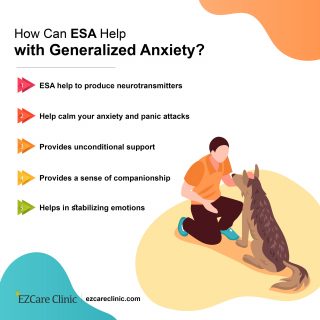
How ESA help with Generalized Anxiety
These animals offer their support through actions such as wagging tails and wet noses. Although simple, these gestures go a long way in treating anxiety and other mental disorders. Other than providing much-needed company, their unconditional love boosts your self-esteem. That’s how the idea of Emotional Support Animals came to be. Acquiring a licensed ESA letter involves the following steps:
-
Online research
Various websites offer genuine ESA letters. If your busy schedule can’t allow you to visit a doctor, ensure you conduct thorough online research on official websites.
-
Fill the necessary form
Once you identify the right site, you’ll fill a questionnaire that seeks more information about your condition and support animal. Details include the type of breed, weight, color, vaccination history, and whether it’s crate trained.
-
Contact with a therapist
Genuine ESA letter approvals don’t happen instantly. You’ll get in touch with a licensed therapist, who’ll evaluate your request more exhaustively. The doctor should be licensed in your state. Make sure you give them a frank account of your anxiety attacks, as well as any other mental conditions you might have.
-
Receive your ESA letter
Once your doctor hands over the ESA letter, you can take your pet assistant onboard planes and other places with pet restrictions. It doesn’t come as a surprise that these animals are a source of comfort. They help balance your blood pressure during stressful encounters. Playing with them increases serotonin and dopamine, hormones that make you feel relaxed. It also reduces stress-causing hormones such as cortisol.
How ESAs Affect Your Life?
There are several advantages of having emotional support animals, one of which is a healthier lifestyle. Their constant companionship and fulfillment of basic needs have a significant influence on your physical and mental wellbeing. Other than anxiety, ESAs can help cure disorders such as depression and PTSD.
Get examined for your mental health by clicking the button below!
3. Exercise
Among the many tips you’ll come across for healing anxiety, exercise will be one of the most consistent. Although physical workouts by themselves don’t cure the disorder, their physical and psychological benefits will make you feel better. Exercise also helps get rid of the mental cobwebs that cause inaction.
One intense workout session can reduce anxiety symptoms for hours, while regular ones diminish them over time. While everyone benefits from physical exercise, you stand to gain more, especially if you haven’t been active before. Let’s discuss in detail how you can use it to tackle anxiety and other mental conditions.
Staying Healthy to Manage Stress
Scientific studies recommend at least 21/2 hours of moderately intense exercise every week, 11/4 hours of intense workouts, or a combination. The following tips will help you manage anxiety through exercise:
- Perform aerobic activities. They include jogging, walking, dancing, and biking for at least half an hour daily, five times a week.
- Have achievable targets and aim for consistency. For instance, a daily 20-minute walk is healthier than a single 3 hour run at the weekend.
- Research workouts that don’t feel like chores. Several types are fun and easy to follow.
- Music acts as a beautiful distraction during exercises because time seems to pass faster. It also puts you in the right mood and helps you achieve more.
If you implement these activities patiently, they’re bound to become healthy habits. Exercise improves your mental wellbeing in the following ways:
- It prevents an obsessive focus on your anxiety by shifting attention to your physical needs.
- Rhythmic movements release muscle tension, which ultimately reduces physical triggers to anxiety.
- Your heart rate increases during exercise. This situation produces anti-anxiety neurochemicals that positively alter brain activity. They include serotonin, brain-derived neurotrophic factor (BDNF), endocannabinoids, and gamma-aminobutyric acid (GABA). Exercise reduces the risk of anxiety attacks in people who are yet to experience them.
- Workouts activate the brain’s frontal lobes, which control your reaction to perceived threats. This situation reduces the overreaction that’s commonly associated with anxiety attacks.
- Other than physical resilience, exercise also boosts emotional maturity, which helps you adopt a more logical approach to situations.
Get Enough Sleep:
Sleep is a natural relaxation and healing activity. It not only makes your brain calm but also keeps your body refreshed. According to science, adults should have at least seven hours of sleep per day for proper physical and mental health. Why is sleep essential for anti-anxiety therapy?
For one, the medial prefrontal cortex part of the brain gets deactivated while you sleep. This action results in lower feelings of stress and anxiety. If your mind doesn’t rest, it triggers an emotional roller coaster that affects your judgment. Sleep deprivation impairs mental functions, which leads to overloaded body systems. Over time it causes confusion, memory loss, anxiety, and depression nursing diagnosis. It also creates hormone imbalances that increase anxiety. Sleep increases protein production, which repairs damage to the body caused by stress.

Tips to Get Peaceful Sleep with Anxiety
How to Cultivate a Healthy Sleeping Habit?
Implement these practical tips if you want a good night’s sleep:
- Embrace a healthy diet
Your diet helps shape your personality and overall lifestyle. Avoid foods loaded with fat and sugar because they can interfere with your sleep patterns. Have consistent meal plans that keep your mind and body sufficiently replenished. Taking too long without food can trigger your nervous system, which will make it harder to sleep. You should also avoid eating too close to your bedtime. We recommend at least three hours between your last meal and bedtime.
- Avoid or reduce caffeine, nicotine, alcohol, and drug intake
Caffeine, nicotine, and drugs such as diet pills act as stimulants that make it hard for the brain to shut down for sleep. Train yourself to take your last caffeinated drink several hours before going to sleep. Alcohol and chain-smoking also keep you in a state of light sleep that doesn’t do your body favors.
- Design a relaxing bedtime ritual
If you have a routine that you follow before going to bed, your body will start associating it with sleep. These tasks include taking a warm bath, drinking herbal tea, and listening to soft music. Try to sleep and wake up at the same time every day.
- Create a relaxing atmosphere
It’s advisable to sleep in a room without brain-stimulating distractions such as electronics. A darker place helps your body produce a hormone known as melatonin, which manages sleep-wake cycles. Other tips include having a comfortable bed, as well as a bedroom with a fresh, pleasant smell and the right room temperature.
- Have short naps
Daytime naps interfere with your sleep pattern. If you must, keep them short of ensuring you still fall asleep relatively fast when bedtime comes. We also recommend keeping a clock out of sight because looking at it might trigger emotions that increase anxiety. Deep sleep helps reinstate your brain’s prefrontal mechanism, which adjusts emotions. It reduces unwarranted reactions, which in turn keeps your anxiety levels in check.
Get help to keep your sleep schedule on track by clicking the button below!
4. Emotional Freedom Technique (EFT)
This approach is also known as EFT tapping. It works on the concept that humans are a fusion of emotions and feelings. It’s therefore vital to align your thoughts with the situation you’re experiencing. This change is not easy if you suffer anxiety because you’ll have a hard time controlling your thought patterns.
EFT is one of the most successful solutions to anxiety attacks. It taps into your body’s energy spots to restore a perfect balance between its physical and mental aspects. With EFT, you’ll be able to put emotional distress behind you in the following steps:
-
Look for a specialist
EFT is an alternative method of anxiety treatment, so ensure you visit a qualified and licensed practitioner. Their experience and expertise will help you achieve the results you seek.
Talk to a mental health expert at EZ Care Clinic!
-
Pay attention to the source of your anxiety
You’re encouraged to focus on the issue you seek treatment for as the practitioner taps specific parts of your body, mainly the head and face. These points are also called meridians and are stimulated in a similar way to acupuncture and acupressure. The specialist uses fingertips instead of needles.
-
Release negative energy
As your energy points get tapped, you’ll become more self-aware and enlightened about what’s wrong with your mental health. This process helps you do away with negative thoughts and embrace positive aspects of your life. While tapping, you should repeat an uplifting phrase that will clear the dark clouds that have been pulling you down.
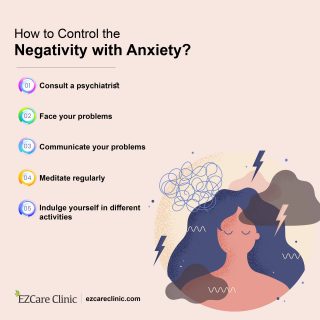
How to Control Negativity with Anxiety
The tapping follows a sequence from the top of the head to the armpit. EFT works on the belief that taking care of the body is central to treating mental health conditions. By engaging your body during the process, you express a readiness to tackle new challenges. Other than being free, quick, and easy to learn, you can practice EFT almost anywhere.
An Important Point to Note
As with every successful activity, consistency is vital. EFT isn’t a one-time solution; you must perform it regularly to avoid reviving your subconscious programming. The phrase you use while tapping is also essential. It should be a mantra that’s specific enough to hit the root cause of your anxiety, not just universal yearnings.
Regain your mental health by clicking the button below!
5. Use Time Management to Tackle Anxiety
Anxiety can be amplified by tight schedules, approaching deadlines, and overwhelming commitments from work, home, or personal life. As you try to juggle everything, you might end up feeling the effects of burnout. In time, the emotional and physical strain will cause anxiety, which will only make things worse.
- Develop a Plan
You can keep stress and anxiety at bay by planning and scheduling everything you do. Time management is a prime strategy that effectively tackles these mental vulnerabilities. Try the following management tips to minimize or eliminate stress:
- Plan Everything
Break your day into one-hour intervals and assign an activity to each. This habit makes it easy to decide how much you can realistically handle. Doing so allows you to be productive while keeping your mind and body free of stress.
- Organize Your Time
Writing a to-do list is a tried and tested time management strategy. It allows you to focus only on productive activities that improve your career and personal life. The feeling of striking off completed tasks boosts your morale and overall mental health. Other organizers include calendars and post-it notes. You can also download them as apps that increase convenience.
- Break Down Big Goals
If you have a significant project, you can split it into smaller milestones. This convenience will prevent burnout and stress that can occur when you try to accomplish it all at once. Every step you clear gives you the confidence to tackle the next one until the project is complete.
- Take Tiny Breaks
Breaks allow your mind to recharge by having happy thoughts. No matter how hectic your schedule is, include an allowance for breathers. You should also anticipate emergencies to pop up, so having a little free time might address them.
- Celebrate Your Achievements
Reward yourself every time you reach your goals. You’ll have a positive outlook on future tasks that will reduce stress and other anxiety triggers.
6. Take Effective Medication
Coping with anxiety without medication is nearly impossible. The right medication can conclusively treat anxiety and its associated symptoms. These pills are often prescribed together with other types of therapy. To prevent addiction to prescription medication, some anxiety-treating drugs are prescribed on a short-term basis. The main types of anxiety medication are:
Benzodiazepines and Antidepressants
Of the countless medications in the market, a combination of benzodiazepines and antidepressants works best at treating anxiety. They do so by balancing the chemicals in your brain. Benzodiazepines help you maintain regular sleep patterns, which prevents other mental disorders from cropping up. Apart from that, Cognitive-Behavioral Therapy (cbt for social anxiety) is also one of the most common forms of modern psychotherapy.
Antidepressants complement them by managing symptoms associated with a wide range of disorders. They include General Anxiety Disorder (GAD), social anxiety disorder, panic disorder, and PTSD.

Common Side-effects of SSRI Medications
Potential Challenges
Although your body has its general features and functions, it also has some variables that make each part unique. Your reaction to medication depends on factors such as diet, preferences, and lifestyle.
Remember, not everyone experiences uniform side effects. Some bodies might reject medication altogether. To
7. Hypnosis
This technique is helpful if you want to become more aware of your subconscious or have a deeper understanding of your mental and physical state. It’s the best type of anxiety therapy, provided you’re focused and absorbed in the procedure. It offers spectacular results if both your body and mind are wholly engaged.
Hypnosis guides your mind towards positive thoughts, which makes it easier to tackle mental instability. The movement between your happy place and reality equips you with the ability to control your emotions during discouraging situations. Hypnosis involves the following process:
-
Find a Qualified Therapist
If performed by a licensed therapist, hypnosis is one of the safest treatment options for anxiety. Before settling on a practitioner, ensure they have the necessary credentials, experience, and certifications.
Although advanced technology makes it easy to find information, it also increases the chances of getting scammed. Some medical professionals also provide hypnotherapist services. They include psychologists, medical doctors, social workers, psychotherapists, and psychiatric nurses.
An experienced practitioner will help you discover your true self by helping your mind explore.
-
Allow Your Mind to Let Go
Consider the following example:
If you’re intensely afraid of heights, your practitioner will introduce that scenario as a “posthypnotic suggestion” while you’re in a trance. Once you’re in that dimension, your mind will be more willing to accommodate suggestions. This eventuality is an opportunity for your therapist to give you the confidence to tackle your fear of heights.
If your phobia manifests itself while under hypnosis, they will help you bypass this “critical factor.” Your mind uses this strategy to protect you while allowing memories that are good to you and blocking harmful ones.
During hypnosis, you should remember these two key points:
- The physical aspect must be involved in the treatment. That’s because it builds a link between your past fear and a physical storage place where those repressed emotions are kept.
- You must learn to overcome the critical factor and get in touch with the parts that direct your reality and perceptions. Relaxation is essential to success!
The Result
If you’re trying to identify the right treatment for your anxiety, hypnosis offers a golden opportunity for remarkable healing. The more sessions you have, the more relaxed you’ll become. These positive factors will ultimately convince your mind to overcome its long-held fears. For complete effectiveness, hypnosis should be applied together with cognitive-behavioral therapy.
8. Energy Healing
This type of therapy targets your body’s energy fields to remove disturbances or blockage in the energy pathways. The restoration of healthy energy flow heals the body of various issues, including anxiety.
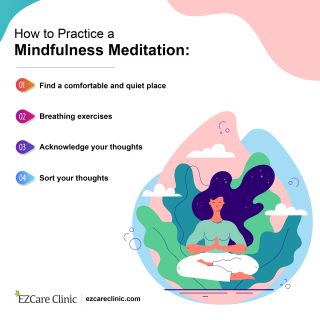
How to Practice Mindfulness Meditation
Energy healing has several benefits, including relaxation, reduced stress, better moods, and improved sleep patterns. It also resolves various symptoms associated with a general anxiety disorder such as irritability, tense muscles, fatigue, and loss of concentration. The energy healing process occurs in these steps:
-
Find a Safe Place
This technique doesn’t require crystal balls or other items associated with magic. You can practice it anywhere you feel safe, whether it’s your room or the public park. The critical requirement is a relaxed mind that allows you to take full control of your thoughts.
-
Focus
You need high concentration levels if you wish to tackle the cause of your anxiety. Breathing is an essential aspect of this step. Become aware of the air intake into your body, the expansion it causes in your chest, and how satisfying it feels to exhale. Some people make it a mantra that improves their concentration. One way of doing so is to say, “I’m inhaling, I’m exhaling.” This phrase has a calming effect on your subconscious.
-
Harness Your Thoughts
Your brain generates countless thoughts at any given time. If you’re suffering anxiety, you’ll have a hard time organizing your thought patterns. You must find a balance between the chaos in your mind and the calm you desire. Rather than giving priority to fearful thoughts, use this focus to release the tension in your mind and body.
Regain your mental health by clicking the button below!
The Power of Energy Healing
If a traumatic experience triggered your anxiety, there’s a possibility that your mind has blocked or frozen that particular event. It will have a strong and negative effect on your nervous system because it still exists in your subconsciousness.
Energy healing utilizes feelings, emotions, and imaginations that have a secure link with your conscious mind. A deep connection with your healer also determines the success of this therapy. You must have intense focus and commitment if you want to do away with negative thought patterns for good.
9. Eye Movement Desensitization and Reprocessing (EMDR)
EMDR is
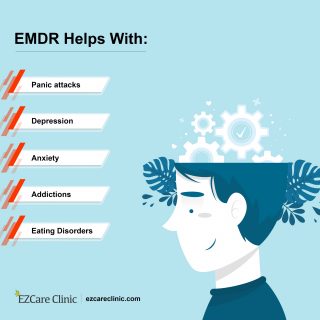
Eye Movement Desensitization and Reprocessing Helps with Multiple Mental Health Problems
Although initially reserved for trauma, EMDR now treats a variety of mental health issues, including panic disorders. The procedure occurs in the following steps:
-
History-Taking
Your therapist will need your complete history to formulate an effective treatment strategy. This list includes past traumatic events, memories, and current situations that stress you. They will develop a customized treatment plan based on these specific details.
Initially, the procedure might focus on childhood experiences, after which it will move to specific issues such as panic attacks. It’s important to know when they started, what triggered them, when you had your worst attack, and when the most recent one occurred.
-
Preparation
This phase teaches you how to handle anxiety and stress. A standard solution is to perform mental exercises.
-
Targeting
This step signals the beginning of hard work. It involves picking a particularly painful memory that you mentioned while narrating your history.
-
Description
Describe a visual aspect of that memory, including how it affects you both emotionally and physically. Your therapist will also ask you to assign negative and positive beliefs about yourself to the visual picture of the traumatic memory. You need to rate these beliefs depending on how true you feel they are, after which the EMDR simulation will take place.
-
Closure
In this stage, your therapist will discuss with you the positive aspects and give you tips on how to reinforce them daily.
-
Re-evaluation
You’ll keep having regular meetings with your therapist, during which you’ll focus on the progress you’ve made. Other points of discussion include a comparison between your treatment goals and whether they’ve been met. If the process is successful, you can focus on other targets that you identified in the initial phases. Your therapist should also show you how to avoid future anxiety triggers.
10. Weighted Blankets
We all love hugs due to the warm and cuddly feelings they give. Kids weighted blankets seek to utilize this principle to treat anxiety. While you sleep, they replicate that soothing feeling, which relaxes your muscles and ultimately improves your sleep patterns.
There’s more to this trend. Weighted blankets for kids were initially used by autistic children and people suffering certain mental conditions. With time the medical community started applying their benefits to the treatment of insomnia and anxiety. Weighted blankets work in the following ways:
-
Deep Pressure Touch (DPT)
It mimics the application of uniform pressure on every part of the body. This action triggers the production of serotonin, a sleep hormone. The result is improved sleeping patterns, lower stress, and a balanced circadian rhythm.
-
Calming Sensation
The Journal of Alternative and Complementary Medicine did a study on the
-
Weighted Blankets Boost Serotonin Production
This hormone is known to reduce pain. Oxytocin, the mood-boosting hormone, also gets released when you sleep under a weighted blanket.
-
Rapid Stress Reduction
Other than the deeper sleep associated with serotonin production, your body unwinds more easily and enjoys relaxation. This process tames your amygdala, the collection of cells in your brain that are responsible for activating the fight or flight function when threatened.
Your sympathetic nervous system creates such impulses. If it gets too busy, it will trigger anxiety. That’s why you need to put significant pressure all over your body to stimulate other parts of your nervous system. Your brain will automatically experience feelings of peace and relaxation.
Regain your mental health by clicking the button below!
Conclusion
At EZCare Clinic, we’re committed to providing the very best in anxiety and mental health solutions. It’s essential to realize that these conditions won’t disappear overnight. These treatment plans require your best effort and time to work. If you’re consistent, you’ll be able to tackle your fears and prepare adequately for any future uncertainties. By following the tips outlined above, you can pursue healing and a healthier lifestyle. Contact us today for an appointment with our specialists.
Sources
- The Power of Pets. (2018)
Source link - The benefits and risks of benzodiazepines. (2023)
Source link - EMDR: Eye Movement Desensitization and Reprocessing. (2023)
Source link - The biologic effects of grounding the human body during sleep as measured by cortisol levels and subjective reporting of sleep, pain, and stress. (2014)
Source link
